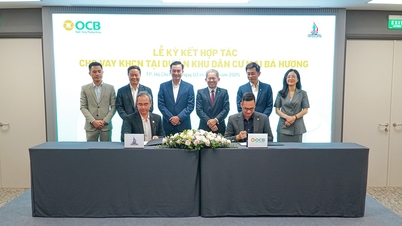
Waiters work at a coffee shop in Ho Chi Minh City - Photo: HP
Falling birth rates are not just happening in Vietnam.
At the rally to celebrate World Population Day on July 11, Minister of Health Dao Hong Lan said Vietnam is facing major challenges such as the lowest birth rate in history, increasingly serious gender imbalance at birth, and rapid population aging.
These factors directly affect the country's sustainable development. The declining birth rate is one of three important factors (along with increased life expectancy and migration) leading to population aging. This is not only a demographic issue, but also a problem that affects the social and economic stability of a country.
The problem of falling fertility rates is not unique to Vietnam. According to the United Nations, the global average fertility rate has more than halved since the 1960s and is now below the “replacement level” (2.1 children per woman) in most countries.
A report by the United Nations Population Fund (UNFPA) shows that nearly 20% of adults of reproductive age in 14 countries surveyed believe they will not be able to have the number of children they want.
The cause is not due to physiological problems but external obstacles such as financial and medical limitations and anxiety about world changes.
Preparing for an aging society in Vietnam
Sharing with Tuoi Tre Online , Professor Giang Thanh Long - a senior lecturer at the National Economics University, who has many studies on population and social security - said that the first problem when talking about population aging is to clearly distinguish between current elderly people and future elderly people, because each group has different characteristics and needs its own approach.
Accordingly, the current elderly (80 years old and above) are a generation that experienced war, lived in deprived conditions and did not have the conditions to contribute to pension insurance programs like today.
Therefore, it is legitimate for them to receive social benefits and the State and society need to be responsible for taking good care of, ensuring income security and protecting the health of this group of elderly people.
Meanwhile, the younger generation, in their 30s and 40s, have more favorable conditions to prepare for their future seniors. They have jobs, income, and opportunities to participate in social insurance, savings, and health care.

An elderly person living in Hanoi is exercising - Photo: NGUYEN BAO
According to a survey conducted by Professor Long and his research team in 2019, many people in their 30s believe that "old age is still far away", while people in their 40s and 44s begin to worry about income, health, savings, etc.
To enter the elderly group proactively and firmly, they need to be assured of employment, stable income, participate in social and health insurance, and form savings habits and maintain both physical and mental health.
"Without the right tools, policies and communication, it is difficult for young people to proactively prepare for their old age. That means we need to 'awaken' the younger generation now so that they are aware of what to do before they become elderly," Professor Long shared.
This becomes even more important as it is forecasted that by 2045, Vietnam will have about 26.4 million elderly people (those aged 60 and over). At the same time, the size of the labor force tends to decrease.
Without a transformation to improve labor quality and increase productivity right now, Vietnam may find it difficult to achieve its goal of becoming a high-income country.
According to calculations by Professor Dwight Perkins (Harvard University) and Dr. Vu Thanh Tu Anh, senior lecturer at the Fulbright School of Public Policy and Management, in the period 2019 - 2030, for Vietnam's GDP to increase by 5%, TFP needs to increase by an average of 2.4% per year. In the case of GDP growth of 7%, TFP needs to increase by 4%, which is also a high level compared to the present.
Regarding the economic growth target, Dr. Tu Anh analyzed that about 20 years ago, Vietnam's labor force increased by an average of 2% per year. However, this number is now only about 0.5% and is expected to continue to decrease due to the aging population.
To compensate for the decline in the labor force, Vietnam is forced to increase TFP and this depends on many factors.
Source: https://tuoitre.vn/muon-tang-truong-nhanh-viet-nam-phai-chuan-bi-cho-gia-hoa-dan-so-som-20250711175023665.htm


![[Photo] Cat Ba - Green island paradise](/_next/image?url=https%3A%2F%2Fvphoto.vietnam.vn%2Fthumb%2F1200x675%2Fvietnam%2Fresource%2FIMAGE%2F2025%2F12%2F04%2F1764821844074_ndo_br_1-dcbthienduongxanh638-jpg.webp&w=3840&q=75)
![[Photo] 60th Anniversary of the Founding of the Vietnam Association of Photographic Artists](/_next/image?url=https%3A%2F%2Fvphoto.vietnam.vn%2Fthumb%2F1200x675%2Fvietnam%2Fresource%2FIMAGE%2F2025%2F12%2F05%2F1764935864512_a1-bnd-0841-9740-jpg.webp&w=3840&q=75)











































































































Comment (0)